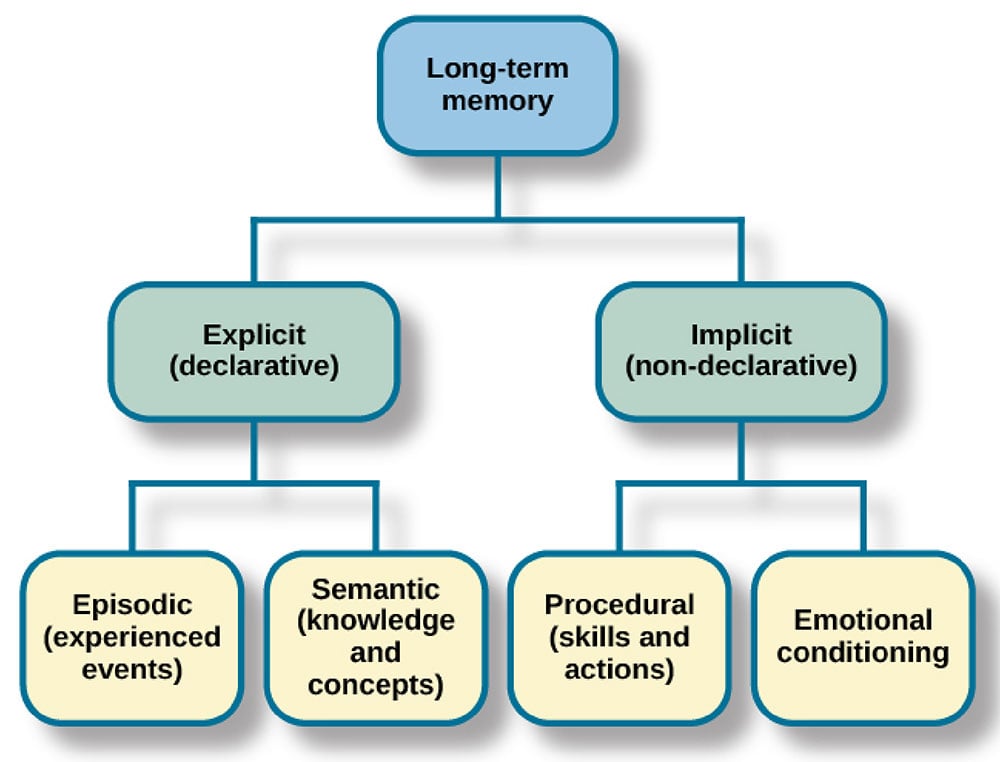Declarative memory, also known as explicit memory, is a type of long-term memory that involves conscious recall. It’s divided into two categories: semantic memory for facts and general knowledge, and episodic memory for personal experiences and specific events.
Key Takeaways
- Long-term memory is not a single store and has two components: declarative (explicit) and non-declarative (implicit). Implicit memory (non-declarative) includes procedural memory and things learned through conditioning.
- Declarative memory has to do with the storage of facts and events we have personally experienced. Recalling information from declarative memory involves some degree of conscious effort, as information must be consciously brought to mind and “declared.”
- Episodic memory and semantic memory are components of long-term memory known as explicit or declarative memory.
- Semantic memory involves the recall of ideas, concepts, and facts commonly regarded as general knowledge. Episodic memory, on the other hand, involves the recollection of personal events or episodes in a person’s life, such as birthdays.
- Throughout our lifetime and there is a gradual transition from
episodic to semantic memories.

Declarative memory is part of long-term memory involving “knowing that”, for example, London is the capital of England, zebras are animals, and the date of your mum’s birthday (Cohen and Squire, 1980).
Declarative memory is also known as explicit memory, as it consists of information that is explicitly stored and involves conscious effort to be retrieved. This means that you are consciously aware when you are storing and recalling information.
Types of Declarative Memory
Episodic memory, together with semantic memory, is part of the division of memory known as explicit or declarative memory.
While episodic memory involves a person’s autobiographical experiences and associated events, semantic memory involves facts, concepts, and skills acquired over time.
Episodic Memory
Episodic memory is part of long-term declarative memory and comprises a person’s unique recollection of experiences, events, and situations.
The Canadian psychologist Endel Tulving first introduced the term ‘episodic memory’ in 1972 to distinguish ‘remembering’ from ‘knowing.’
Specific events, general events, personal facts, and flashbulb memories constitute different types of episodic memory.
They are a person’s unique memory of a specific event, so it will be different from someone else’s recollection of the same experience, e.g., your first day of school.
Episodic memory has 3 elements: specific details of the event (time and place), context (what happened next), and emotions (how you felt).
Examples of episodic memory include: recalling your first abroad, remembering where you were when you heard that Mr. Trump had won the 2016 election and the memory of your first day in college.
Types of Episodic Memory:
- Specific events involve the recollection of particular moments from an individual’s autobiographical history. Recalling the first time you dove into the ocean is an example.
- General events involve recalling the feelings associated with a certain type of experience. Recalling what it is like to dive into the ocean, in general, is an example of this type of episodic memory. You may not remember each occasion wherein you dove into the ocean. But you do have a general recollection of having dived many times into the ocean—upon which your feeling is based.
- Information intricately tied to a person’s experiences constitute personal facts. Knowing the color of your first bicycle and the name of your first dog are some examples.
- Flashbulb memories are exceptionally vivid and highly detailed ‘snapshots’ of moments or circumstances wherein you learned important or surprising pieces of news (Brown & Kulik, 1977). Recalling the moment you heard about the death of a family member or a major tragedy such as the 9/11 attacks might be an example.
- It should be noted that there is much debate as to whether the vividness of a flashbulb memory stems from a virtual flash produced by the emotional intensity of a specific experience, or from a propensity to rehearse consequential moments—which can immensely strengthen the memory.
Neural Networks
It is possible to store episodic memories in auto-associative neural networks provided that the representation of the stored memories contains information about the spatiotemporal context wherein the representation was examined (Khalil, Moftah & Moustafa, 2017).
Neural networks, which enhance the comprehension of the transmission and the reception of various messages to and from the body, comprise interconnected structures or neurons which harmoniously produce different intra-brain cognitions (Henderson, 2012).
Additionally, these networks can contract or expand based on the type of information being processed at a given time (Nestor, Kubicki, Gurrera, Niznikiewicz, Frumin, McCarley & Shenton, 2004).
Semantic Memory
Semantic memory is a type of long-term declarative memory that comprises facts about the world that are not linked to particular events or contexts. Semantic memory involves “knowing that” (e.g., Paris is the capital of France).
The Canadian psychologist Endel Tulving first introduced the term ‘semantic memory’ in 1972 to distinguish ‘remembering’ from ‘knowing.’
Semantic memory concerns knowledge about the world which is shared by everyone rather than personal knowledge, this
may relate to the functions of objects, what behavior is appropriate, or even abstract concepts such as maths.
Some examples of semantic memory:
- Recalling that Washington, D.C., is the U.S. capital and Washington is a state.
- Recalling that April 1564 is the date on which Shakespeare was born.
- Recalling the type of food people in ancient Egypt used to eat.
- Knowing that elephants and giraffes are both mammals.
Episodic and Semantic Memory
Together, episodic memory and semantic memory constitute explicit or declarative memory, which is part of long-term memory. Episodic memory involves a person’s recollection of temporally dated information that permits the agent to mentally travel back in time and associate emotions with experiences.
Semantic memory, on the other hand, involves a structure of recorded skills, facts, and concepts acquired over time—via the accumulation of episodic memories. For instance, while each visit to Paris may constitute an episodic memory, the experiences of how Paris looks would constitute the semantic representation of the word ‘Paris.’
Furthermore, contrary to Tulving’s original proposal that episodic memory and semantic memory competed against each other for retrieval, more recent research based on experiments on LSA (Latent Semantic Analysis) suggests that the strength of semantic cues on retrieval is positively correlated with the strength of episodic cues (Howard & Kahana, 2002).
Additionally, impacts on episodic memory seem to affect semantic memory. For instance, the damage wrought to the medial temporal lobe through conditions such as anterograde amnesia impairs both episodic memory and semantic memory (Tulving & Markowitsch, 1998).
Frequently Asked Questions
What are the two components of declarative memory?
Declarative memory, a part of long-term memory, is composed of two components: semantic memory and episodic memory.
Semantic memory refers to our memory for facts and general knowledge about the world, while episodic memory relates to our ability to recall specific events, situations, and experiences that have happened in our personal past.
What is the difference between declarative and nondeclarative memory?
Declarative memory, also known as explicit memory, involves the conscious recall of facts (semantic memory) and events (episodic memory). In contrast, non-declarative or implicit memory involves unconscious recall and influences our behavior without awareness.
It includes procedural memory (skills and habits), priming (changes in perception and belief caused by prior exposure), and classical conditioning (learned responses to stimuli).
References
Berryhill, M. E., Phuong, L., Picasso, L., Cabeza, R., & Olson, I. R. (2007). Parietal lobe and episodic memory: bilateral damage causes impaired free recall of autobiographical memory. Journal of Neuroscience, 27 (52), 14415-14423.
Brown, R., & Kulik, J. (1977). Flashbulb memories. Cognition, 5 (1), 73-99.
Clayton, N. S., Salwiczek, L. H., & Dickinson, A. (2007). Episodic memory. Current Biology, 17 (6), R189-R191.
Cohen, N. J., & Squire, L. R. (1980). Preserved learning and retention of pattern analyzing skill in amnesia: Dissociation of knowing how and knowing that. Science, 210, 207–209.
Deisseroth, K., Singla, S., Toda, H., Monje, M., Palmer, T. D., & Malenka, R. C. (2004). Excitation-neurogenesis coupling in adult neural stem/progenitor cells. Neuron, 42 (4), 535-552.
Grainger, A. (2008). Difficulties in tracking the long-term global trend in tropical forest area. Proceedings of the National Academy of Sciences, 105 (2), 818-823.
Henderson, J. M. (2012). “Connectomic surgery”: diffusion tensor imaging (DTI) tractography as a targeting modality for surgical modulation of neural networks. Frontiers in integrative neuroscience, 6, 15.
Howard, M. W., & Kahana, M. J. (2002). When does semantic similarity help episodic retrieval? Journal of Memory and Language, 46 (1), 85-98.
Janowsky, J. S., Shimamura, A. P., & Squire, L. R. (1989). Source memory impairment in patients with frontal lobe lesions. Neuropsychologia, 27 (8), 1043-1056.
Khalil, R., Moftah, M. Z., & Moustafa, A. A. (2017). The effects of dynamical synapses on firing rate activity: a spiking neural network model. European Journal of Neuroscience, 46 (9), 2445-2470.
Maguire, E. A., & Frith, C. D. (2003). Aging affects the engagement of the hippocampus during autobiographical memory retrieval. Brain, 126 (7), 1511-1523.
McCloskey, M., Wible, C. G., & Cohen, N. J. (1988). Is there a special flashbulb-memory mechanism? Journal of Experimental Psychology: General, 117 (2), 171.
Nestor, P. G., Kubicki, M., Gurrera, R. J., Niznikiewicz, M., Frumin, M., McCarley, R. W., & Shenton, M. E. (2004). Neuropsychological correlates of diffusion tensor imaging in schizophrenia. Neuropsychology, 18 (4), 629.
Scarf, D., Gross, J., Colombo, M., & Hayne, H. (2013). To have and to hold: Episodic memory in 3‐and 4‐year‐old children. Developmental psychobiology, 55 (2), 125-132.
Schacter, D. L., Gilbert, D. T., & Wegner, D. M. (2011). Semantic and episodic memory. Psychology, 2, 240-1.
Tulving, E. (1972). Episodic and semantic memory. In E. Tulving & W. Donaldson (Eds.), Organization of Memory, (pp. 381–403). New York: Academic Press.
Tulving, E. (1985). Memory and consciousness. Canadian Psychology/Psychologie canadienne, 26( 1), 1.
Tulving, E. (2002). Chronesthesia: Conscious Awareness of Subjective Time. Principles of Frontal Lobe Function, pp. 311–325.
Tulving, E. (2010). Précis of Elements of episodic memory. Behavioral and Brain Sciences, 7 (2), 223–238.
Tulving, E., & Markowitsch, H. J. (1998). Episodic and declarative memory: role of the hippocampus. Hippocampus, 8 (3), 198-204.


